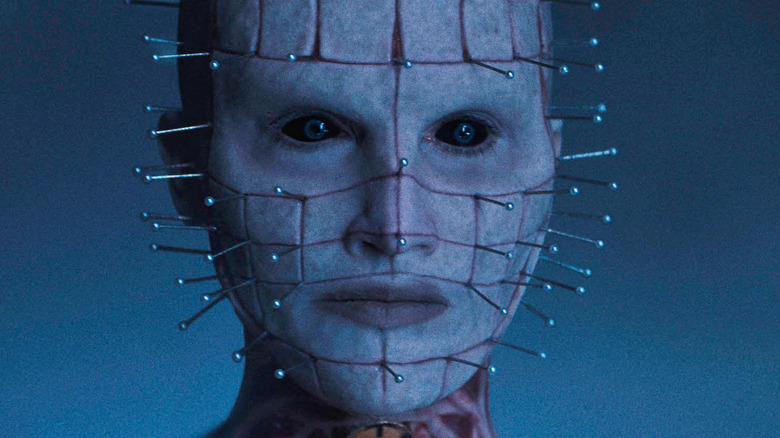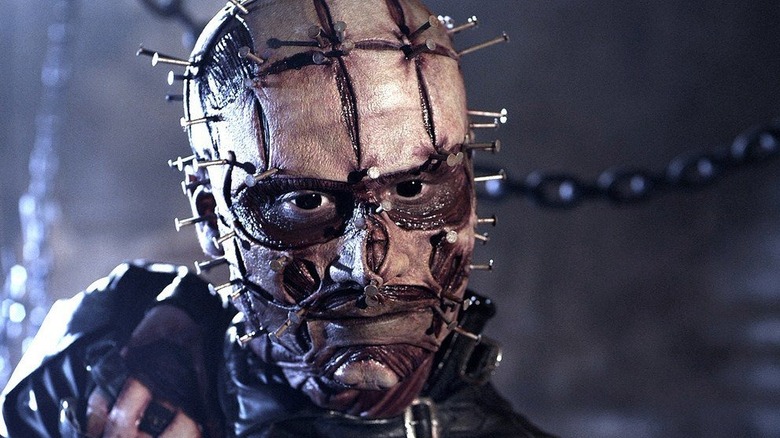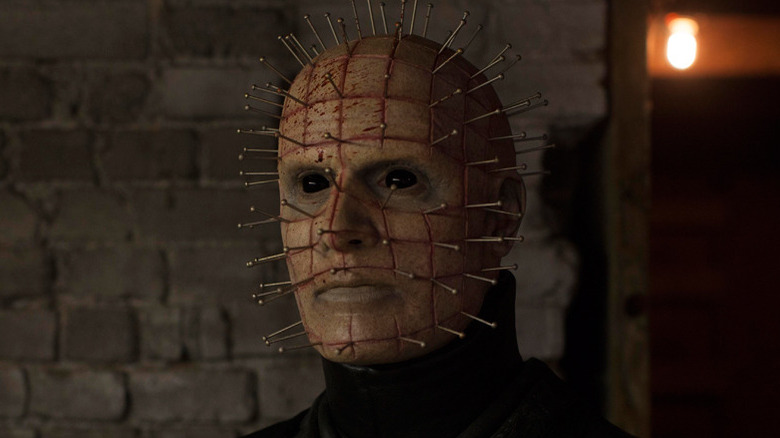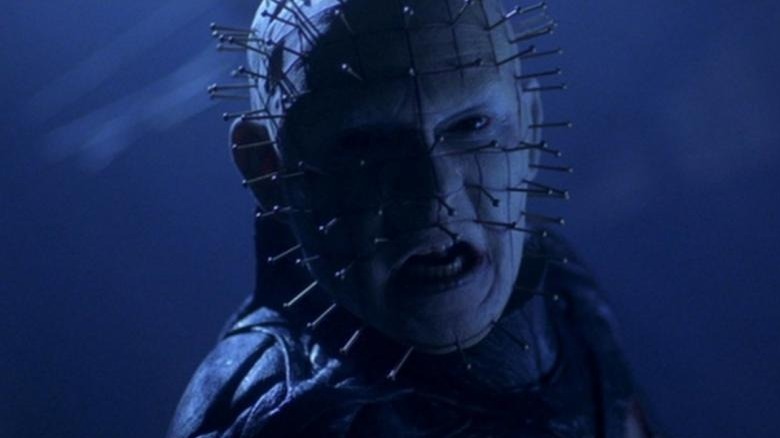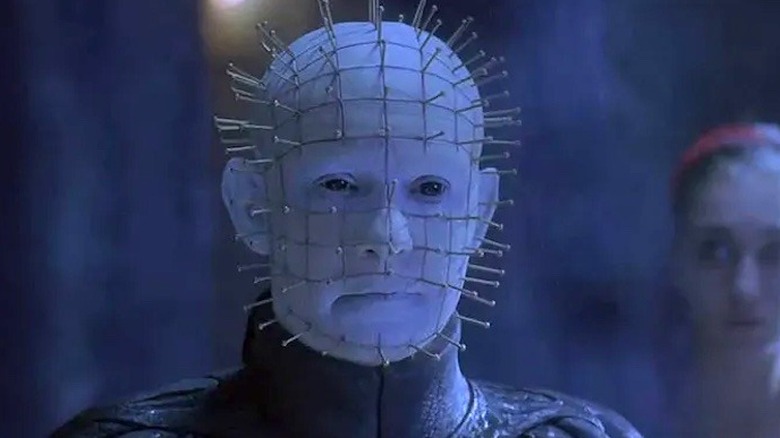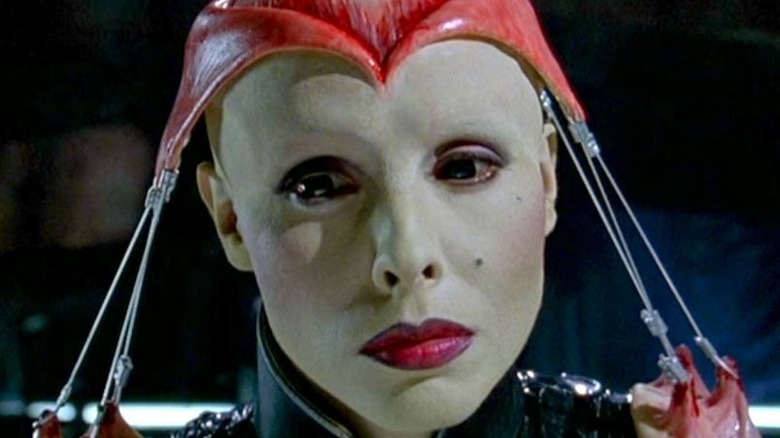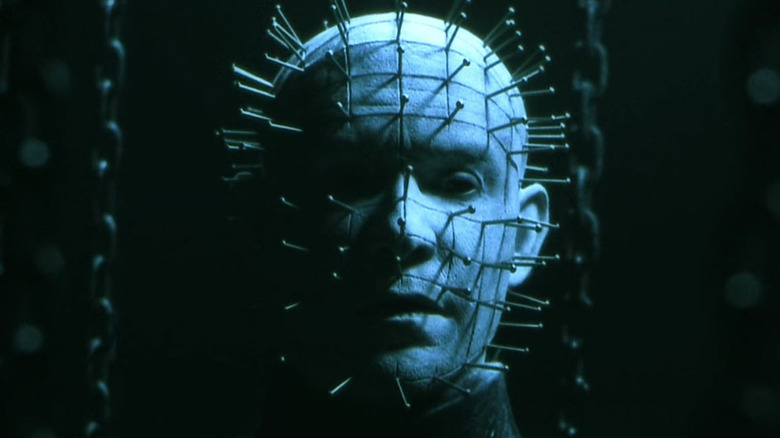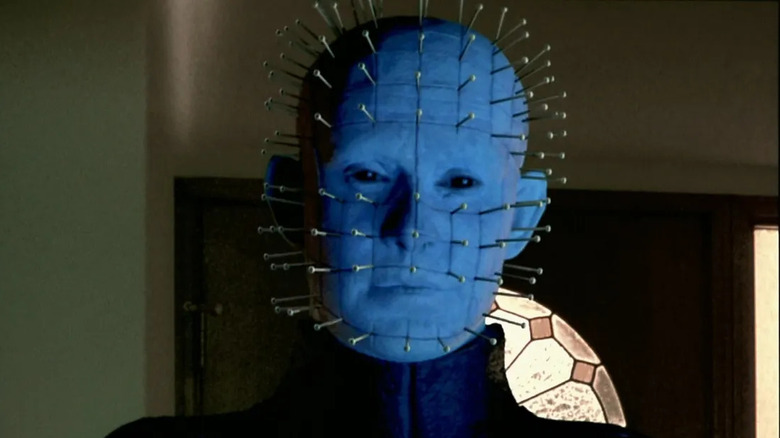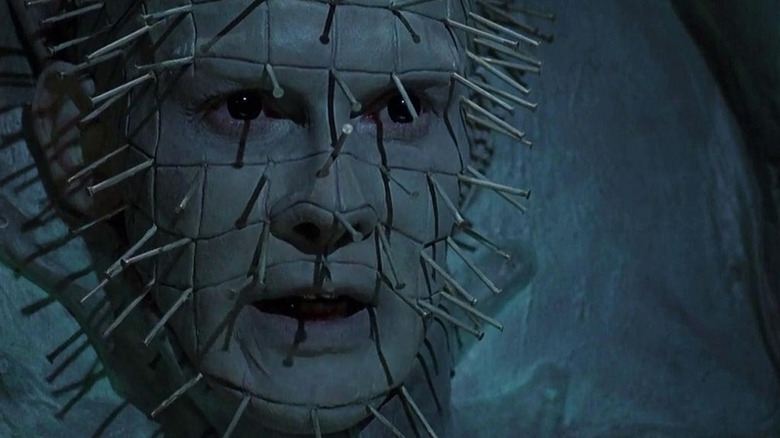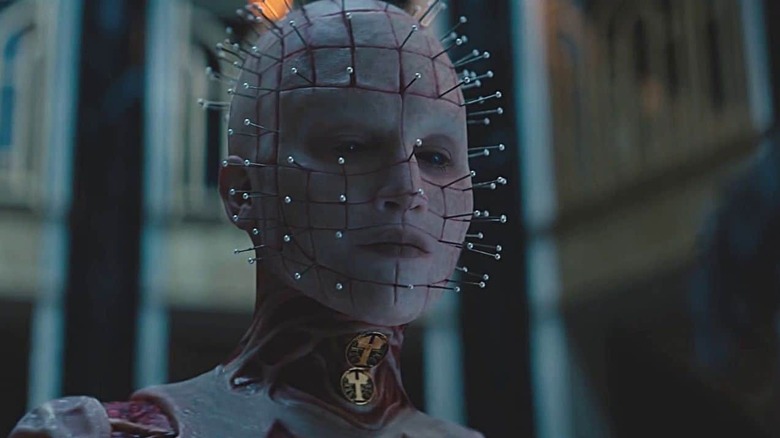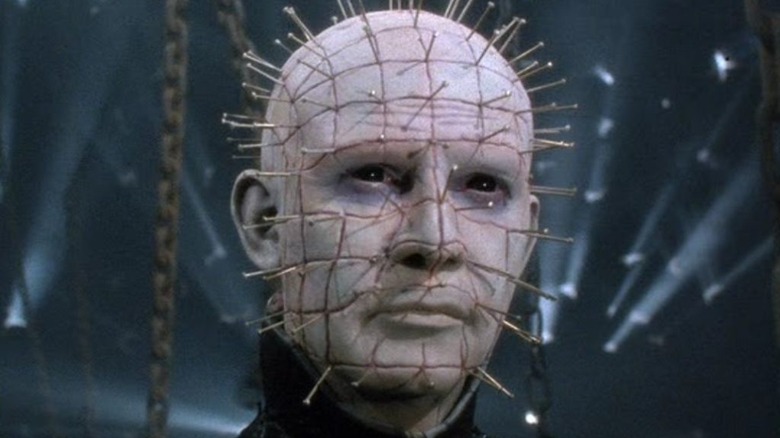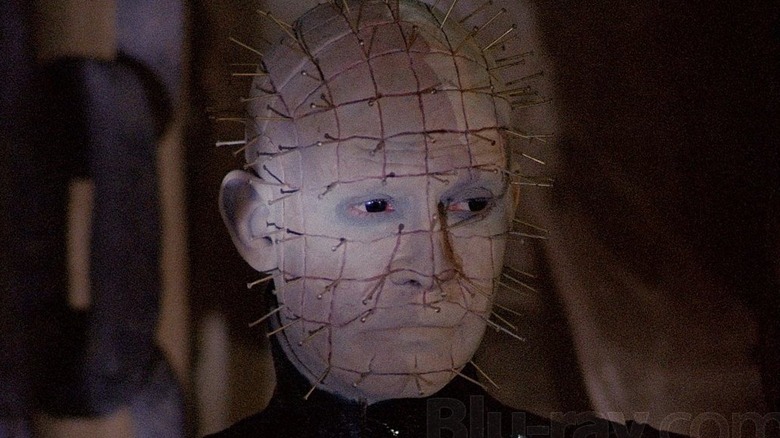Every Hellraiser Movie Ranked Worst To Best
Before his foray into film, legendary author Clive Barker was already revered in horror circles for his debut collection "Books of Blood," praised by Stephen King, who dubbed the writer "the future of horror." Within a year of its release, Barker was hired to write a pair of low-budget monster movie slashers, including the British B-movie "Transmutations" and the infamous "Rawhead Rex."
But in 1987, he took on his most ambitious project yet, translating his own short story "The Hellbound Heart" into a feature film, and this time, he stepped into the director's chair too. A landmark horror film, it became an instant hit with fans looking for something more than a psychopathic killer picking off teens in what had become a tired trope of the genre. With its success, sequels quickly followed, with "Hellbound" released a year later. Suddenly, the next horror franchise was born, and Pinhead joined the pantheon of horror's greatest iconic monsters.
Nearly a dozen sequels later, Barker himself has long since moved on from the series, but the films have kept coming. So how do they rank? Outside of the first pair, opinions on every subsequent sequel have found little consensus. You're bound to find contradictory opinions and reviews, some labeling each one utter trash, a bottom-of-the-barrel bore, while there are inevitably other reviewers who manage to find bright spots in every film. Suffice to say, the "Hellraiser" series is one of the hardest to rank with any kind of authority. But after combing through dozens of reviews, we think we've found the sweet spot.
11. Hellraiser: Revelations
Following a series of failed low-budget, direct-to-DVD sequels, the studio behind "Hellraiser" thought the best way to revive the franchise was to reboot it with a low-budget, direct-to-DVD sequel. Reportedly rushed into production and filmed in just two weeks on a budget of $300,000, it seems the only reason the movie exists was so that producers could retain the rights to the franchise (via Bloody Disgusting). Well, with a new actor as Pinhead for the first time in the series, a cast of B-movie rejects, and a budget less than a third of the first "Hellraiser" movie nearly 25 years earlier, the results speak for themselves.
A sad, pathetic excuse for a film, it only qualifies for this list because we promised to rank them all. In a story that absolutely feels like it was written and filmed in two weeks, some friends head to Mexico to party, only to be introduced to a certain demonic puzzle box by a mysterious stranger, bringing Pinhead and other bizarre beings called cenobites to Earth. The story makes little sense, the editing is confusing, and the characters are little more than props to push the plot to the end.
On the plus side, there are some decent attempts at genuine gore, which is what the franchise has always been about. But the film is not frightening, is not at all compelling, and is frankly a complete mess. As a quick rights-holder, it did its job, but perhaps it would have been better to let someone new take a crack at reviving the series.
10. Hellraiser: Judgment
Seven years after "Revelations" was churned out, another reboot came to fruition, this time with actor Paul T. Taylor in the role of Pinhead. Unfortunately, the results weren't much better than before, though it certainly looked better (like an actual film). The real problem for "Hellraiser: Judgement," though, is that in an attempt to recapture some of the spirit of the original 1987 classic, the team overplays its hand and winds up turning the picture into another junker, complete with some unnecessary misogyny, too.
On the one hand, the film rightly pushes Pinhead himself to more of a background role, as it was really the sequels that turned him into the star. The cenobites themselves boast unique and appealing new designs — appealing for fans of "Hellraiser," we should say — but the story is haphazard and sloppy. Though it opens with some suitably horrific and graphic torture scenes that will satisfy longtime viewers who come looking for just that sort of thing, the rest of the movie doesn't.
It focuses on a trio of detectives investigating the mysterious murder of a young woman. They soon discover that a bizarre serial killer is at work, and that leads to an encounter with various demons, other-worldly beings, and of course, the puzzle box that summons Pinhead. All we can say is, "Better luck next time."
9. Hellraiser: Hellworld
Attempting to bring the "Hellraiser" franchise into the 21st century, the tagline of the direct-to-DVD "Hellraiser: Hellworld" didn't do much to instill confidence in fans that this would be a return to its gothic horror roots. "Evil Goes Online" indicated that Pinhead would be headed to cyberspace, a concept that in 2005 already seemed a decade out of date. Nevertheless, "Hellworld" — released the same year as "Hellraiser: Deader" — still had original star Doug Bradley in the role of Pinhead, which was enough to lure back most diehard fans and bring a little bit of gravitas and respectability to an otherwise cringe-inducing premise.
Starring a then-unknown Henry Cavill almost a decade before he'd become Superman in "Man of Steel," the seventh "Hellraiser" installment strays so far from the concept created by Clive Barker that it's almost unrecognizable. In a nearly fourth-wall-breaking story, the film follows a group of young friends who become obsessed with a new online video game called "Hellraiser: Hellworld," which is based on their favorite horror movie franchise. But in playing through the different levels, the gamers accidentally unleash the very real cenobite Pinhead into their totally-not-a-movie world.
Though the cast is an impressive one — with Cavill joined by "Aliens" android actor Lance Henriksen and future "Vikings" star Katheryn Winnick — the film was a weak attempt to put a fresh spin on a slowly dying series. Its cheap production and downright boring story didn't help matters. The end result was that the studio shuttered the franchise, opting for a clean reboot six years later.
8. Hellraiser: Deader
Another quickly slapped-together sequel, 2005's "Hellraiser: Deader" was originally an unrelated script that was retrofitted to incorporate Pinhead and the cenobites. It was also initially seen overseas in 2002 and took three years to make it stateside, likely due to its low quality. As such, it was released domestically the same year as "Hellworld" as another direct-to-video release. And though it may not be one of the worst films in the series, it's incredibly generic, and one can definitely tell that it is a movie that was heavily rewritten.
Starring a mostly unknown cast with the exception of Kari Wuhrer ("Sliders"), it follows reporter Amy Klein, who is on assignment in Bucharest, where she is tracking a death cult that claims to be able to reanimate the dead. There she meets the leader of the group, Winter LeMarchand, a descendant of the French artisan who originally created the demonic puzzle box that summons Pinhead and his fellow cenobites. Winter believes he can control the cenobites that the box unleashes but needs Amy's help to open it.
Being based on a spec script may be plainly obvious for fans of "Hellraiser," but it's not all bad, and it actually helps in offering up some fresh new material for the franchise. It's a fairly straightforward story, which is appreciated, and its imagery does evoke the classic franchise look and feel. Nevertheless, it's a cheap and half-hearted attempt to sucker "Hellraiser" fans and is ultimately a forgettable and mediocre horror vehicle even at its best.
7. Hellraiser: Bloodline
An odd trend in the mid-'90s saw Hollywood taking horror movies into outer space. Perhaps it was an attempt to do something new with a tired genre, but as original movies like "Event Horizon" mixed horror with sci-fi, longtime franchises did the same. This included "Jason X," which had Jason Voorhees slashing away in the year 2455, while "Leprechaun 4" saw the deadly diminutive demon wreaking havoc on a space cruiser. Not to be outdone, "Hellraiser: Bloodline" joined the party by setting the action on a space station in the 22nd century.
But it's not all sci-fi, as much of the film takes the action back some 400 years, where we meet Philip LeMarchand, the French puzzle maker who is commissioned to construct a puzzle box called the Lament Configuration. What he doesn't know is that its designer has built it to be a gateway to hell, and it summons a demon named Angelique. Once he realizes what he's done, he sets out to build a second box that can stop it but is killed before he completes it.
In 1996, a descendant of LeMarchand releases Angelique's rival Pinhead from his own puzzle box, leading to a cenobite war. The action culminates aboard a space station more than a hundred years later, with LeMarchand descendent Paul Merchant intent on finishing his ancestor's work of driving the cenobites away for good. Though it's a flawed film and downright goofy in some respect, it broadens the "Hellraiser" mythology and does something interesting with the sci-fi angle, unlike other similar movies of the era.
6. Hellraiser: Hellseeker
The sixth entry in the series, "Hellraiser: Hellseeker" narrowly edges out "Bloodline" for No. 5 on our list, thanks mostly to the return of Kirsty Cotton from the first three films, some interesting twists and turns, and the notable but uncredited involvement from series creator Clive Baker (as noted by the filmmaker's official website). Actress Ashley Laurence's return as Cotton is a welcome one and helps make it an ever-so-slightly more compelling sequel. Of course, the quality ultimately rests with the story on the screen, and while it may not be among the better "Hellraiser" films, it's an engaging horror thriller that does just enough to engage an audience eager for nail-biting suspense and plenty of spills and thrills.
As for the story, it introduces Kirsty Cotton's husband, Trevor (Dean Winters), who is left mystified when his wife disappears following an accident that sends them and their car off a bridge and into a river. Awakening with memory loss, he's plagued by nightmarish visions until he comes face to face with Pinhead and must confront his own misdeeds.
While Clive Barker's input was minimal — giving the filmmakers notes on minor tweaks to its third act — he reportedly felt it was the best sequel since "Hellbound," which he wrote. While "Hellseeker" is not a great horror movie, it does at least offer a compelling story that harkens back to the original classic as well as the ideas it was known for. It also features a good cast led by Winters and even has a couple of genuine surprises.
5. Hellraiser: Inferno
Placing "Hellraiser: Inferno" this high on the list may prove controversial for some fans, but hear us out. Most of the heaviest criticism levied at the film comes from the fact that it doesn't really feel like a "Hellraiser" film, and for good reason. The script is from Scott Derrickson — who also made his directorial debut on the picture — and was actually written as an unrelated supernatural crime thriller (via JoBlo). Eventually, it was repurposed to become a sequel to the iconic Clive Barker franchise, with a couple of additions to help tie it into the series' larger mythology.
The film centers on a detective (played by Cliff Sheffer, from Clive Barker's "Nightbreed") who discovers the Lament Configuration at the scene of what appears to be a satanic ritualistic murder. After it comes into his possession, though, he begins to suffer strange and grotesque hallucinations. But as he gets closer to finding the killer — a madman known as The Engineer who has abducted a child — his closest associates begin to turn up dead. Now it's a race against time to rescue the killer's next victim while being haunted by the demon Pinhead.
While the story itself bears little resemblance to what fans had come to expect from "Hellraiser," on its own merits as a twisted, psychological thriller, "Inferno" generally works. With future "Doctor Strange" director Scott Derrickson behind the camera, a compelling story, and some trippy visuals, those who go into it with no expectations will be surprised to find a unique horror movie with a style all its own.
4. Hellraiser III: Hell on Earth
Following a pair of lower-budget but highly revered horror classics, a big studio got a hold of "Hellraiser." Seeing dollar signs, Dimension and Miramax clearly threw more money at the filmmakers, as the movie is broader and bolder, with loads of special effects, climaxing in an all-out demon war. Starring actress Terry Farrell — who a year later would sign up for a leading role in the sci-fi spin-off "Star Trek: Deep Space Nine" — the film is filled with big ideas, while Pinhead actor Doug Bradley gives arguably his most interesting performance, as he gets to two separate but intertwined roles.
Exploring the character of Pinhead deeper than ever before, the revelation that he was once a human splits the cenobite into two distinct halves: Pinhead, and his human self, World War I veteran Elliot Spencer. Each half is trapped — Pinhead in a cenobite relic, Spencer in a limbo dimension. The relic, a massive carved pillar, comes into possession of a club owner who is manipulated by Pinhead into releasing him. But a television reporter uncovers the relic and realizes that the demon is attempting to bring hell to their doorstep, and the only way to stop him is to reunite him with his human alter ego.
An intriguing horror mystery, it brings fresh life into the series, but some have criticized its reliance on action and big visuals in the final act, an apparent attempt to be a bigger commercial hit. Despite its aspirations, though, it failed to even match the success of the first film (via The Numbers).
3. Hellraiser (2022)
By 2022, the "Hellraiser" franchise had spent the last 30-plus years suffering through a series of failed sequels and at least two attempts at a reboot that fell flat on their faces. Though series creator Clive Barker had talked about returning to write and direct a loose remake of the first film as far back as 2006, the 2022 reimagining, simply titled "Hellraiser," is an all-new story. But it's one that in many ways harkens back to Barker's original novella, "The Hellbound Heart."
The story does away with the original's sleazy protagonists and centers on a troubled young woman named Riley (Odessa A'zion), who discovers the infamous puzzle box. When it calls forth the otherworldly beings called Cenobites — including its pin-faced Hell Priest (Jamie Clayton) — it takes her brother (Brandon Flynn) back to their realm for eternal torment. To get him back, Riley must face off with a sadistic tycoon (Goran Visnjic) who has fallen to the puzzle box and become the Cenobites' tormented slave, while coming to terms with her own life of sin.
Though this relaunch can't quite match the first films in the franchise, it easily bests most of the long-forgotten sequels thanks to some stylish direction, a strong cast, and a back-to-basics story that is more unsettling psychological horror than gory slasher. Recapturing the dark themes of the Barker's story, 2022's "Hellraiser" is a return to form that most critics seemed to agree was a worthy successor to the original's legacy.
2. Hellbound: Hellraiser 2
Released just a year after the breakout first film in 1988, series creator Clive Barker wrote the script for this first sequel, "Hellbound: Hellraiser II," though he didn't return to direct. A direct continuation of the first film, we get the first hints at the wider lore of the cenobites and the dimension they live. The story picks up directly after the death of Julia Cotton, with her stepdaughter Kirsty admitted to a psychiatric hospital overseen by the sinister Dr. Channard.
Obsessed with her stories of what demons from hell, the doctor takes the Lament Configuration for himself and researches the ancient satanic relic, determined to open it and enter the demon world. After reanimating a skinless, bloody Julia Cotton, the two work to lure Channard's troubled patients to his home so that she may feed on them and rejuvenate her new form. With the help of one young patient, Tiffany, the puzzle box is opened, and the three descend into Pinhead's domain. Now it's up to Kirsty to follow them into the demonic realm and rescue Tiffany before she is devoured by cenobites. But to do it, she'll have to get past Pinhead — and Channard, who has become a monster himself.
Thanks to Barker's script and a strong performance by Ashley Laurence as Kirsty Cotton, "Hellbound: Hellraiser II" successfully expands on the first film. It offers up plenty of disturbing imagery, unbelievable twists, and horrific nightmares, making it one of the better horror sequels of the era.
1. Hellraiser
The 1980s were awash in slasher films with demonic killers like Freddy Krueger, Jason Voorhees, and Michael Myers. Then, in 1987, something entirely new and different came along — a groundbreaking horror slasher that redefined the genre. "Hellraiser," written and directed by author Clive Barker and based on his own short story "The Hellbound Heart," was more than a mere murder tale. A gothic horror film, psychological thriller, and a slasher flick all rolled into one, it was as bloody and shocking as "Nightmare on Elm Street" and as disturbing and nightmarish as classics like "Suspiria" and "The Exorcist."
The film centers on illicit lovers Frank and Julia Cotton. A twisted madman, Frank obtains a curious puzzle box that is said to be a doorway to a realm of unfathomable pleasures, but when he uses it, he is brought before the cenobite Pinhead and taken to hell. But an accidental drop of blood from his brother helps resurrect him, and now Julia must bring him human victims to rejuvenate his body. Discovering the puzzle box, Julia's step-daughter Kirsty witnesses their murder spree and must find a way to send Frank back to hell.
Unlike anything audiences had seen before, "Hellraiser" set a new bar for horror in the 1980s, with a compelling story in addition to plenty of gore and shocking scares. Sparking a new subgenre of horror, there have been many imitators — and even many of its own sequels — that have failed to recapture the brilliance of the original.
